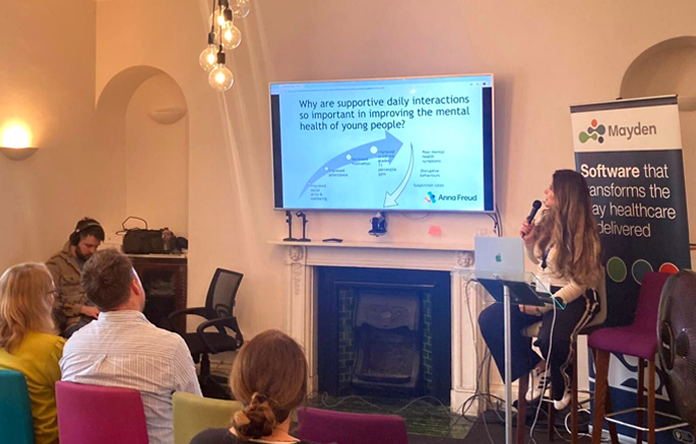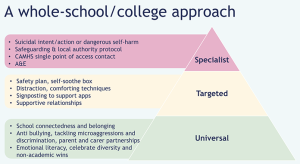
Hannah Woods, Head of Service, Schools and Colleges Early Support Service from Anna Freud joined Mayden recently as a guest speaker for a half-day event for children and young people’s (CYP) mental health services.
She discussed Anna Freud’s fully remote service and how this allows them to support whole school approaches to mental health and wellbeing.
If you missed the event, you can catch up on demand here.
Hannah walked through the 5 step framework that Anna Freud has developed and published, on how to develop and embed whole school approaches to mental health and wellbeing. This entails working in collaboration with communities and professionals, to scale up support for children and young people and their families.
Step 1: Leading Change for whole school approaches
The first step is to think about how we can embed change within a school setting. Leadership and management are central to pushing forward new initiatives, and this has to be at the centre of whole school approaches. You should follow an implementation model for leading change, involving key supporters who can drive things forward at a senior level.
A good place to start is by looking at policy that already exists within the school setting. This allows you to identify changes that will support the mental health and wellbeing of young people. Part of any policy that is implemented should include core processes that will be followed to support students suffering from mental health difficulties.
School leaders can also explore the culture and ethos of the school environment; cultivating a safe and open climate that normalises conversations about mental health. You can take a values based approach across the school community. Students and staff are more likely to feel a sense of belonging through building crucial relationships when values align with positive wellbeing. This allows students and staff to build a sense of safety, share vulnerabilities and establish purpose.
Confidentiality and safeguarding must be considered at this first step, for example:
- How will you explore the limits of confidentiality with students?
- How will you support communications with parents and carers?
- How will you keep accurate records?
- Have you provided signposting support to students, parents and carers?
- Have you included all members of staff in communications
- Have you considered neurodiverse students?
These factors must be at the forefront of the minds of staff supporting students with mental health difficulties.
Step 2 – Working Together
As part of developing your whole school approaches, you must bring the whole school community together, including engaging with parents and carers to provide the right level of support for young people.
Whole school approaches need to have:
- Universal support, for example: establishing peer support programmes, having robust mental health and wellbeing policies, and educating all staff about child and family mental health.
- Targeted support, for those who may need 1-2-1 interventions (eg teaching grounding/comforting techniques, psychoeducation and signposting, and co-produced safety plans
- Options for specialist support

You can choose to implement personalised safety plans, working with EMHP’s to ground them within school mental health policies, which help individuals who are struggling.
Some key aspects to include in a safety plan may be:
- Identifying warning signs
- Developing healthy coping strategies
- Building a strong support network,
- Removing access to dangerous behaviours e.g. self harm, and finding healthy substitutes for those negative behaviours.
On a practical level, you should ensure that any safety plans include what to do and who to contact in a time of crisis, taking care to regularly review the safety plan and identifying a trusted adult within the school setting that is responsible for checking in with the student who is struggling.
Step 3 – understanding need – how do we understand need and measure impact?
There are many factors that make young people vulnerable to suffering from mental health difficulties, for example, bullying, peer pressure, history of trauma, academic stress and lack of support.
To understand the need, we can look out for certain warning signs in young people, which can be split into the following categories: behaviour, physical signs, psychological, and social.

Within school settings, staff can play a big role in enhancing improvements in protective factors of young people, which will help them to deal with adversity/risk factors when they are faced with them.
These factors include:
- individual (eg developing positive self image),
- relationships (eg building a sense of connectedness and belonging),
- family and community (ensuring a safe environment at home and school),
- society (eg access to crisis support when needed).
School staff can embed these things on a whole school level to support children and young people as much as possible.
School transitions can influence emotional safety and attachment due to factors such as disruption of routine, separation anxiety, academic pressure, adjustment challenges and much more.
Lots of things happen at points of transition that need consideration on a whole school level and measures to support young people to get through these transition periods should be implemented.
Read more here: Supporting School Transitions – Top Tips for MHSTs
Step 4 – promoting wellbeing of the whole school community
To promote wellbeing, you can take a relational approach, emphasising connection through interactions and communications. This will highlight the importance of psychological safety for the young person. Relationships should be at the heart of school life, and this in turn can improve the mental health of young people: improved social skills and wellbeing can lead to improved attendance, increased motivation and ultimately, improved academic performance.
Step 5 – supporting staff
School staff are crucial to embedding whole school approaches; they are the glue that holds it all together. But for staff to be able to effectively support young people, they have to prioritise their own health and wellbeing. By supporting CYP with mental health difficulties, staff may be faced with additional pressures. This can put them at risk of indirectly experiencing difficulties themselves, which can lead to burnout and secondary trauma.
To enable staff to feel fully supported in this environment:
- ensure that they have development opportunities available to them, such as senior mental health lead training.
- make room to have supportive conversations with staff which promote active listening.
- ensure that all staff know where to go if they need support.
The 5-step framework provides a clear roadmap for schools to implement a comprehensive approach to mental health and wellbeing. By adopting these steps, schools can make positively impact their students lives and create a healthier, happier learning environment.
Catch up on all of our webinars on-demand here.
